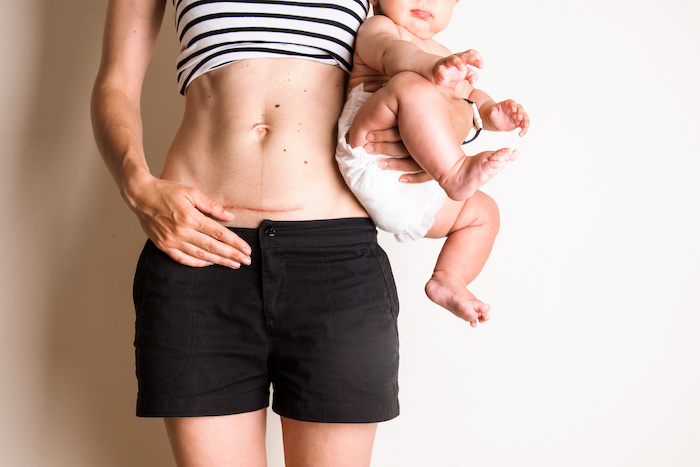Whether you are currently pregnant or planning on getting pregnant, you have probably thought about birthing plans and the different ways babies can be delivered.
While vaginal birth is generally the recommended option in uncomplicated pregnancies, some women may require a C-section due to complications either during pregnancy or while in labor.
It is important to talk to your OB/GYN and other members of your care team to decide on the best plan to keep you and your baby safe and healthy. But it is good to have some information going into those conversations. With any pregnancy, it’s always a possibility, so it’s important to know what to expect if you have a C-section:
What is a C-Section?
A cesarean section, or C-section, is the surgical delivery of a baby through incisions made in the mother’s abdomen and uterus. This is done as an alternative to vaginal delivery. A C-section may be necessary for the safety of the mother and/or baby when a vaginal delivery poses some danger.
A C-section is abdominal surgery, so before the procedure, you will be prepped for the operation. You will be given an IV to administer fluids and medications, which can include anesthesia medication or medication to prevent infection. Your abdomen will be washed and other sanitary measures will be taken. You will also be given a catheter to keep the bladder empty during surgery, which decreases the risk of injury to the organ during the procedure.
A C-section requires anesthesia and you may be given general anesthesia, a spinal block, or an epidural block. General anesthesia will put you to sleep, so you will not be awake during the procedure. The other two methods numb the lower half of the body and you will be conscious during the procedure.
There are multiple layers that your surgeon must go through before reaching the baby. These include incisions in your abdominal wall and then in the wall of the uterus. These incisions can either be transverse (horizontal) or vertical. The doctor and surgical team will deliver the baby through the incisions, the umbilical cord will be cut, followed by the removal of the placenta. The uterine incision will be closed with special stitches that will dissolve into your body as it heals. The abdominal incision will be closed using staples or stitches.
When is a C-Section Necessary
There are certain conditions and situations that make a C-section a safer option than vaginal delivery. The C-section may be planned due to pre-existing conditions or issues that develop during pregnancy. It may also be deemed necessary if complications arise once labor for a planned vaginal delivery has begun.
A C-section may be necessary for one or more of the following reasons:
- Breech presentation
- A very large baby
- Pregnancy with multiples (twins, triplets, etc.) which has an increased risk of premature labor, poor positioning, or other issues
- Maternal medical conditions like hypertension or diabetes
- Maternal infections such as HIV or herpes
- Failure of labor to progress (the cervix may not open enough for the baby to move into the vagina)
- Concern for the baby due to abnormalities detected in fetal monitoring or umbilical cord compression
- Concern for the mother such as hemorrhaging or placenta
- Uterine rupture
- Placental abruption, which is the placenta peeling away from the uterine wall
If you have had a C-section with a previous pregnancy you are more likely to require the procedure for additional births. However, it is possible to have a vaginal birth after cesarean delivery (VBAC) in some cases. Talk to your doctor about the risks to see if you are a candidate for VBAC.
What are the Risks and Complications Associated with a C-Section?
While a C-section does carry increased risks, most complications are usually easily treated. Some of the risks are specific to cesarean delivery, but many are the same as the risks of other surgeries that require anesthesia. The most common risks include:
- Blood loss
- Blood clots in legs, lungs, or pelvic organs
- Adverse reaction to anesthesia or other medications
- Injury to the bowel or bladder
- Infection
What is Recovery from a C-Section Like?
As with other surgeries, recovery from a C-section can vary from woman to woman. Unless you were given general anesthesia, you will be able to see your baby immediately. After delivery, the baby is often placed on the mother’s chest. You should also be able to breastfeed right away.
Typically, the hospital stay after a C-section is two to four days long. While you are in the hospital recovering, your incision will be checked regularly. Your blood pressure, pulse, and breathing will also be monitored following the surgery. You will need to stay in bed for a while after the procedure, but as soon as the anesthesia has worn off you will be encouraged to start taking short walks. The first few times you leave the bed you should have assistance from a nurse or another adult.
The most common issue women experience during recovery from a C-section is pain or soreness at the incision site. Your doctor can prescribe pain medication to ease the pain after the anesthesia wears off after surgery. Other symptoms you may experience during the recovery period include:
- Bleeding or discharge for 4 – 6 weeks
- Cramping, especially if you’re breastfeeding
- Bleeding with clots and cramps
Before you are discharged from the hospital, you will be instructed on how to care for the incision to prevent infection or trauma. You will also be given instructions on limiting your activity and other ways to take care of yourself when you return home.
If you develop a fever or if the pain or symptoms above worsen, contact your OB/GYN immediately as these can be signs of infection.
—
Whether you and your doctor have decided on a scheduled C-section or you require one to safely deliver the baby after the onset of labor, Raleigh OB/GYN will be there for you every step of the way. We strive to create a supportive and nurturing environment no matter the birthing situation. Our doctors, nurses, and staff are all committed to providing the highest standard of care to you and your baby at every stage. To make an appointment, call 919-876-8225 or request one online.


